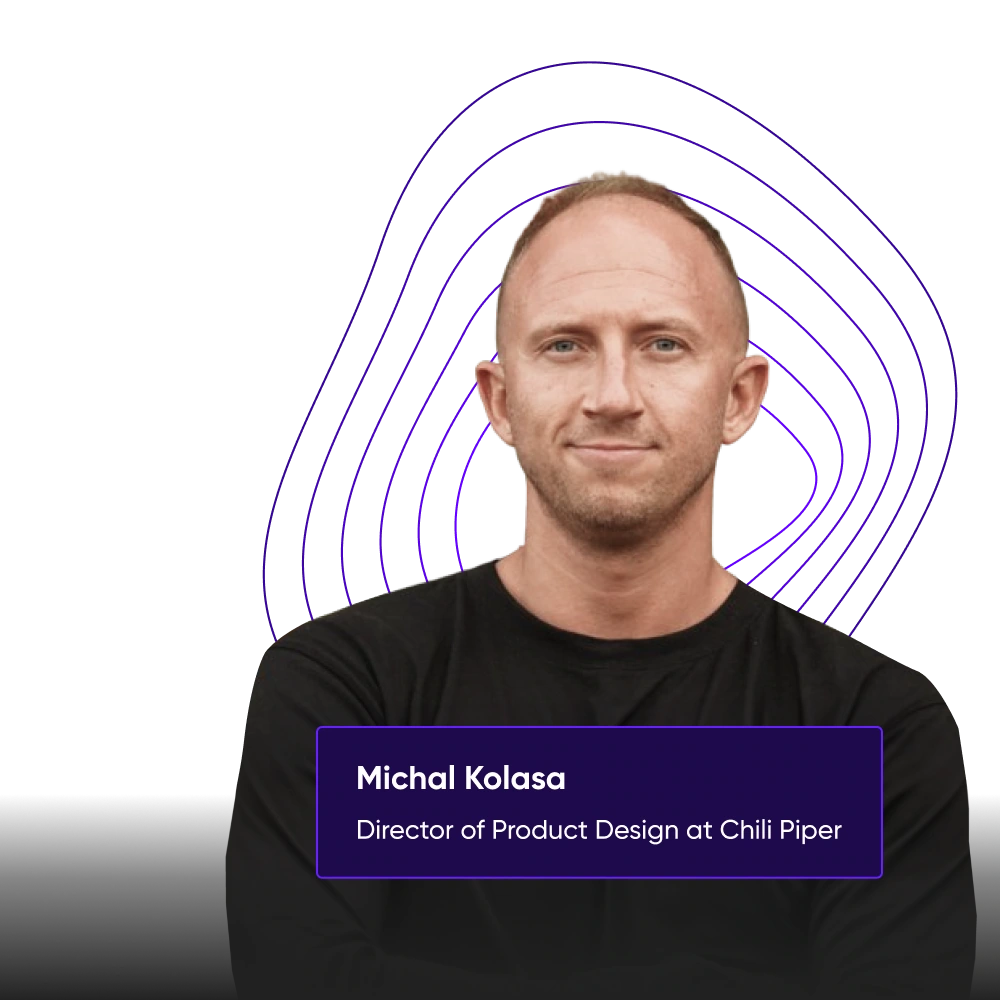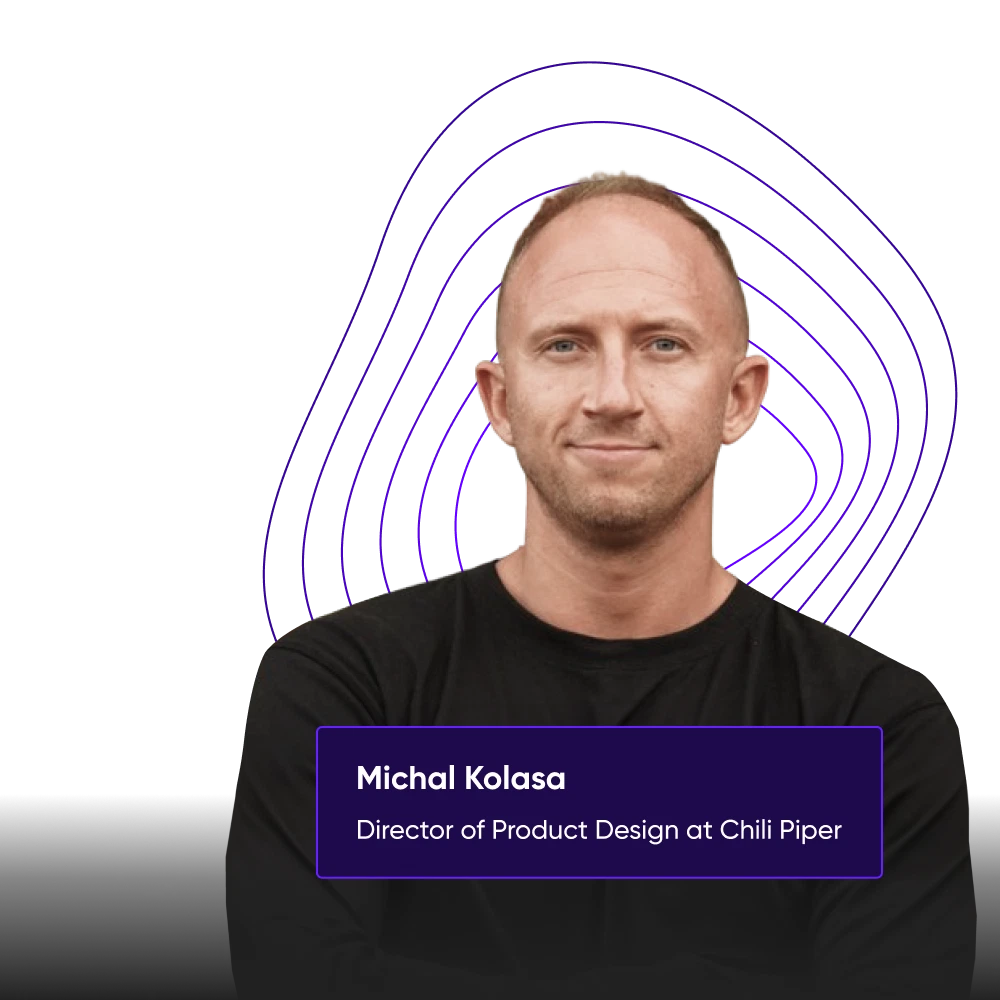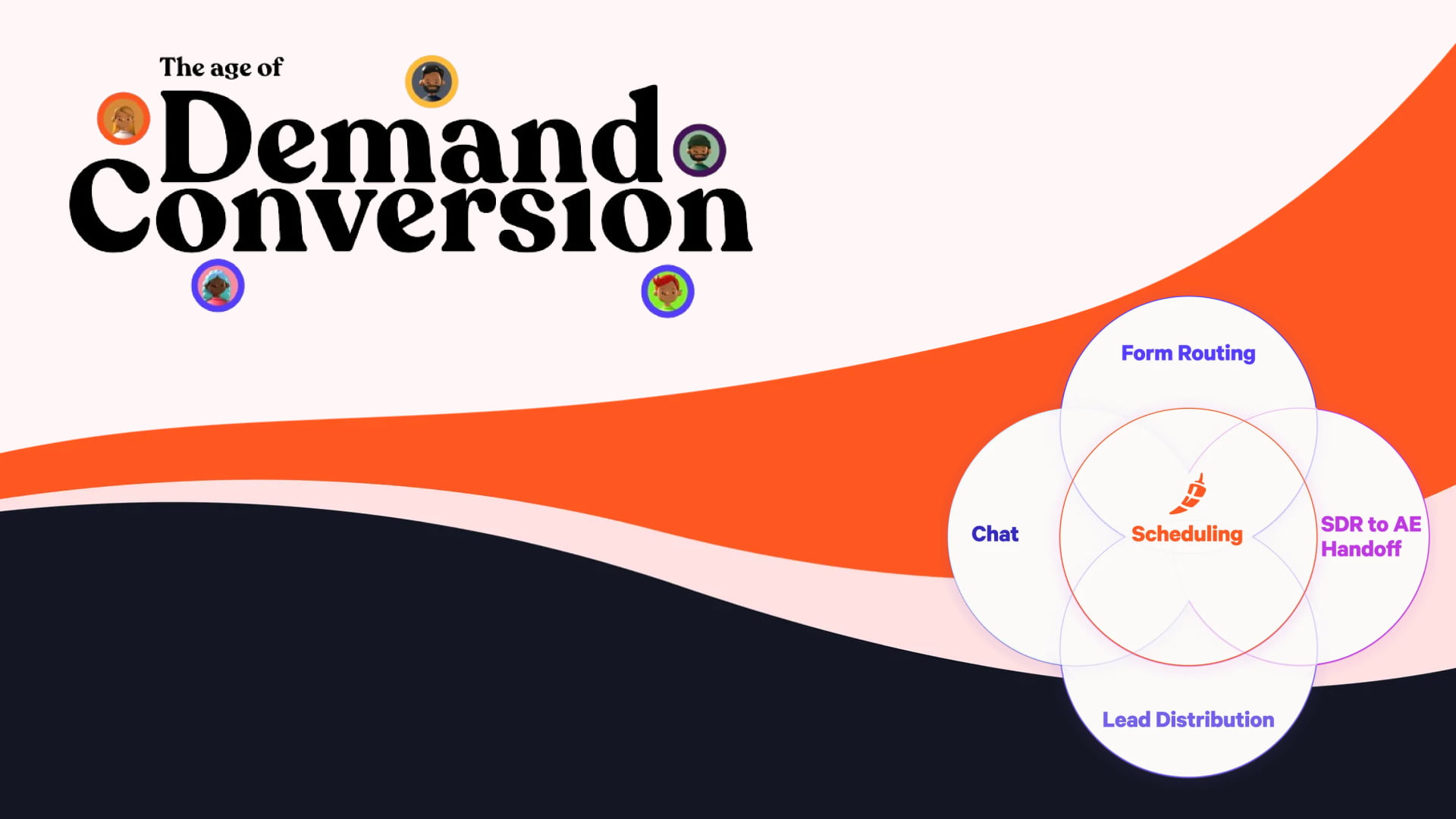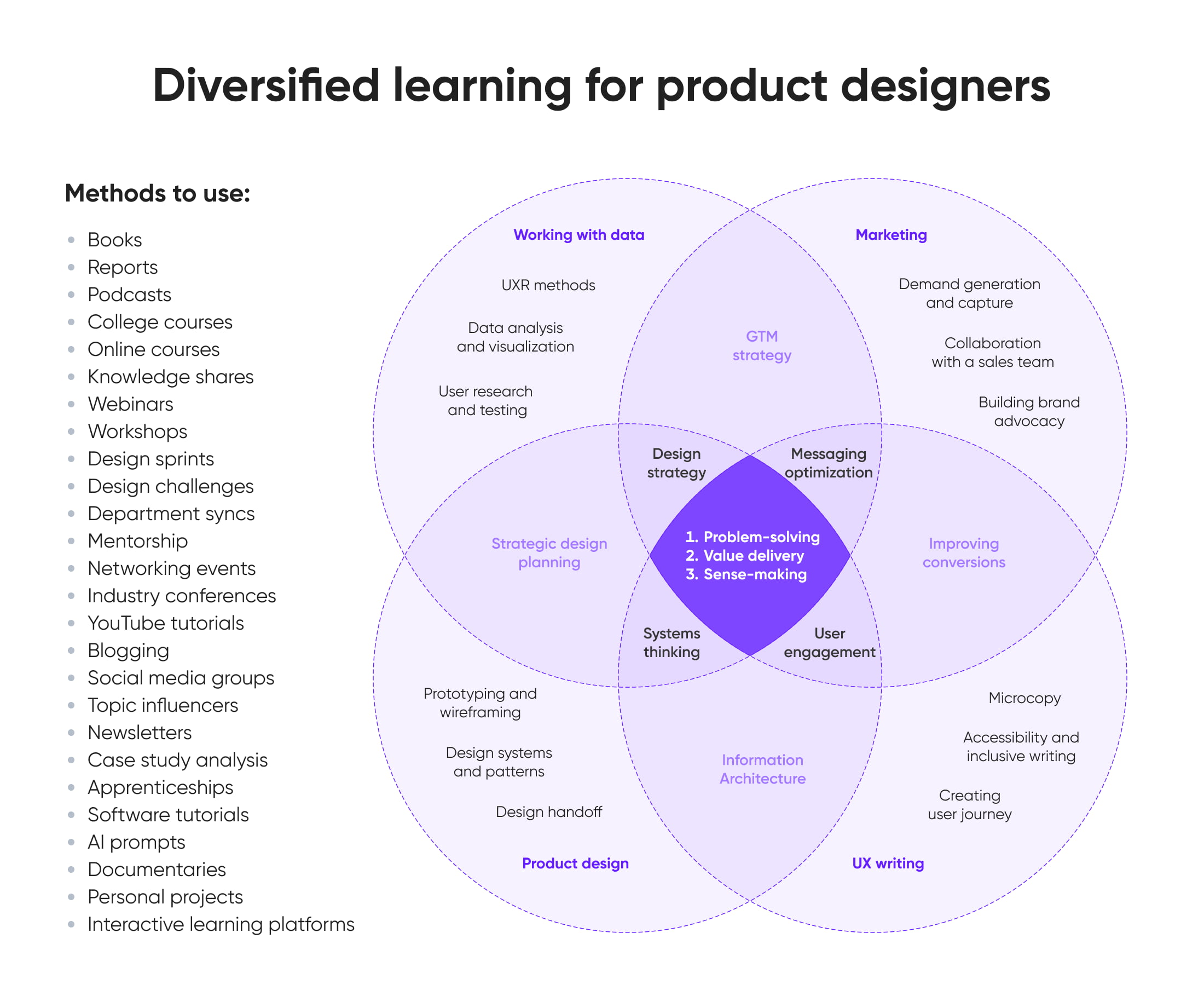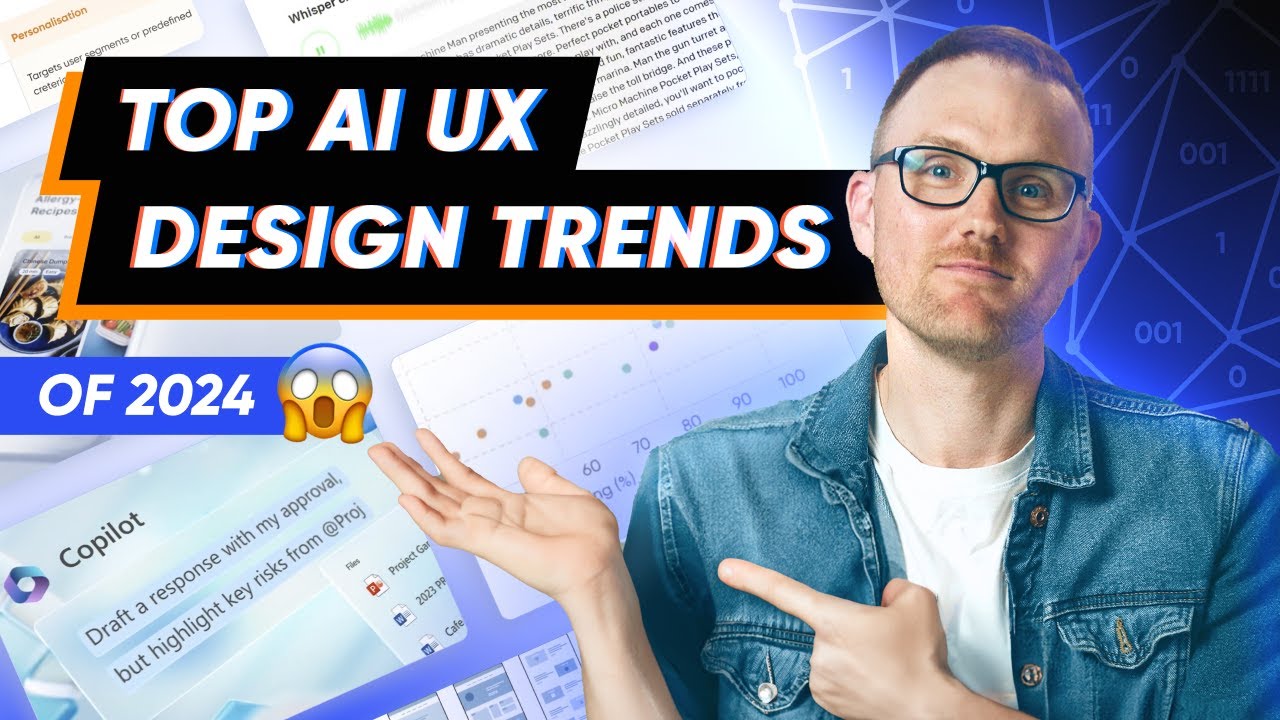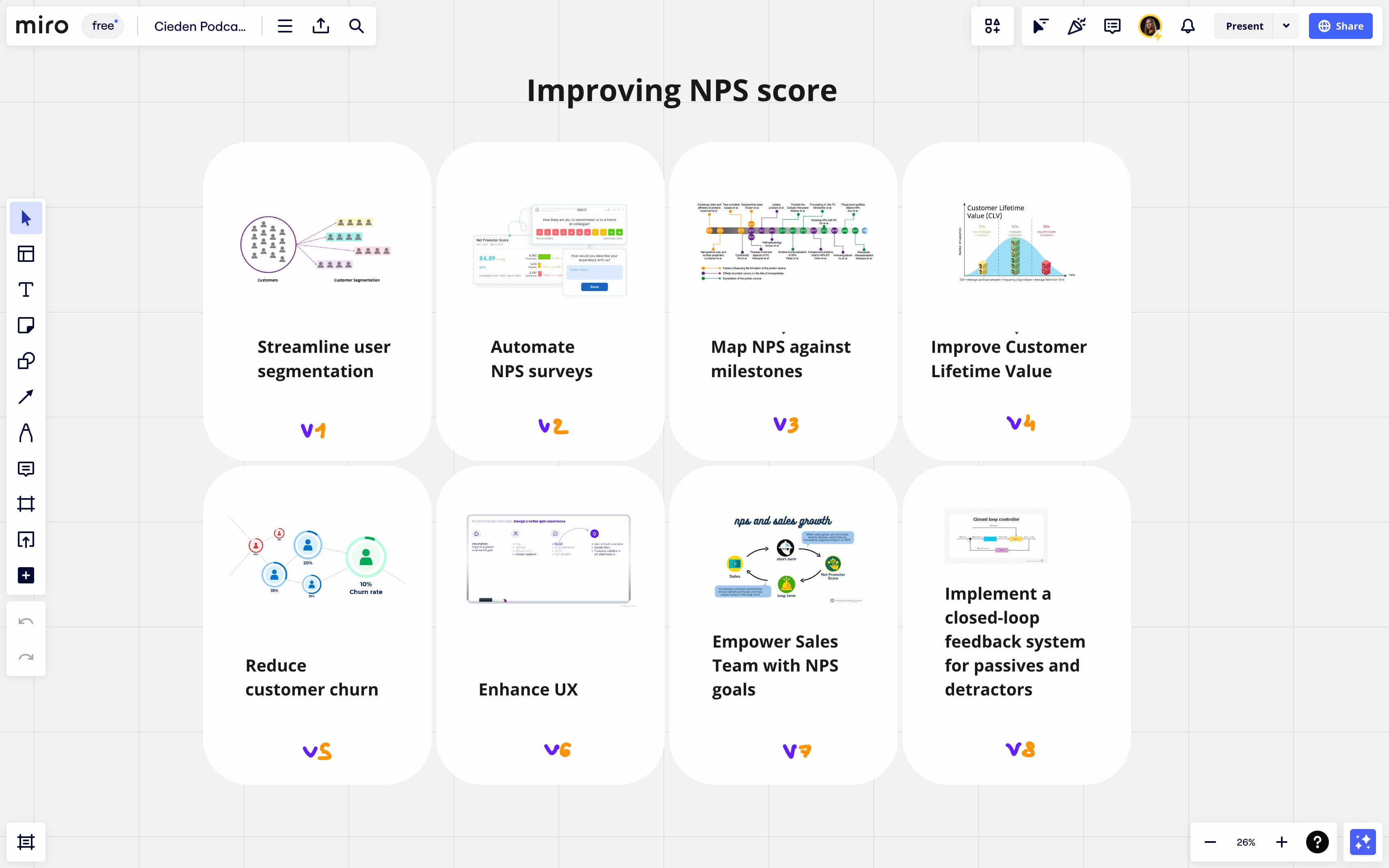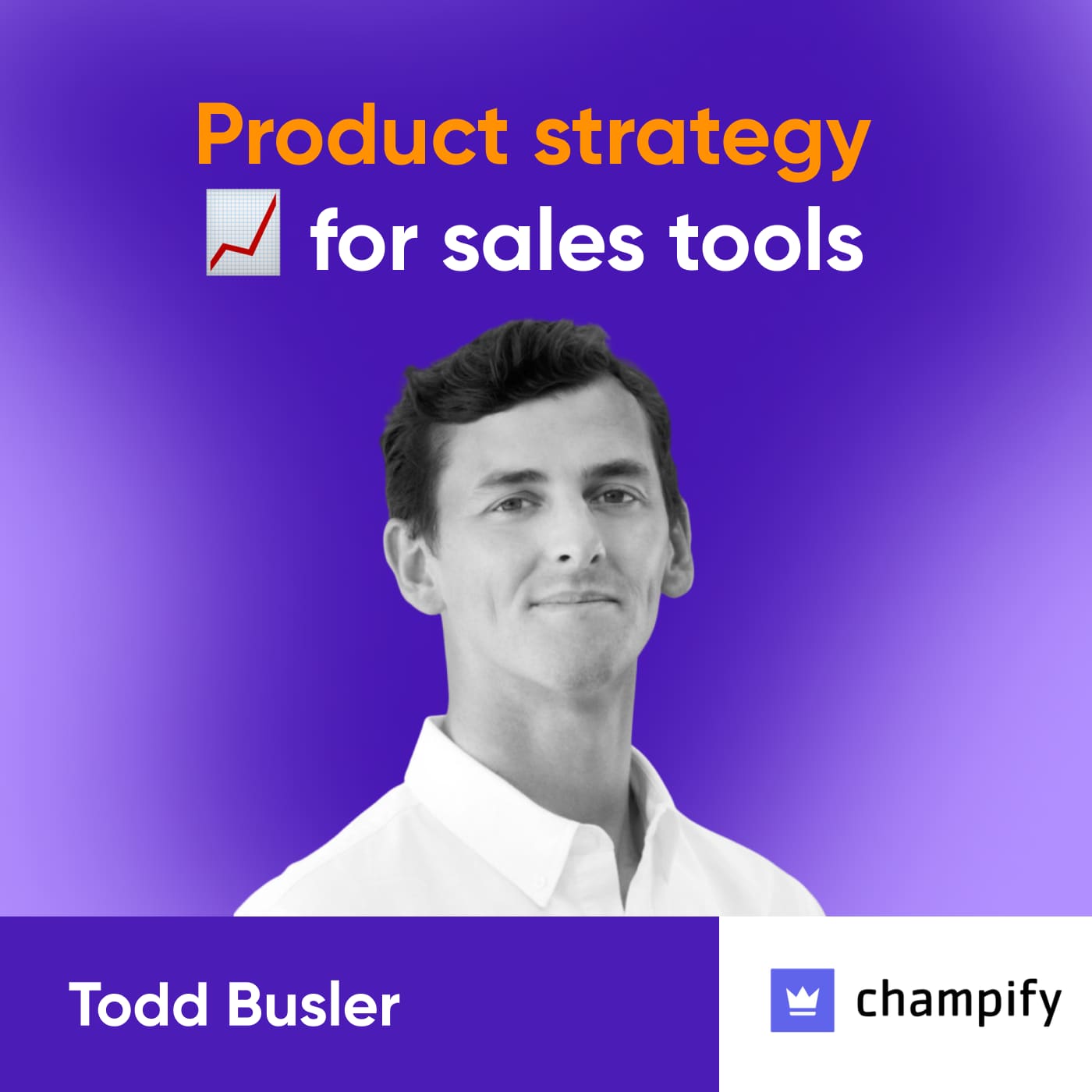In this episode, Michal shares his vision of product design and expertise in enhancing user experiences. We'll also have a discussion on the state of modern design education and how to make remote design teams more creative and productive.
Transition to design management
Yuriy, Co-Founder and CEO of Cieden: Hello and welcome to Cieden Podcast. We have a great guest today—Michal Kolasa, the Design Director at Chili Piper. Chili Piper is one of the leading lead routing software that is changing the world, how the sales operations are made. Michal’s experience is super rich. He started his design career almost 20 years ago as a graphic designer, then had different leadership roles in different companies, in the biggest European marketplace—OLX Group. And now he is building from almost the beginning design competency in Chili Piper.
Michal, welcome to the podcast. It's a great pleasure to meet you in person.
Michal Kolasa, Design Director at Chili Piper: Thank you, Yuriy. Fantastic to be here. Hope to share a couple of experiences that I had and also talk about the things that we are doing right now at Chili Piper.
Yuriy: Awesome. Tell us a few words about your design journey. You started many, many years ago. How did this happen? Why did you decide to become a designer and did you ever want to change this decision?
Michal: So jumping straight to the conclusion that I think it was an excellent choice to go into the field, so to say. Obviously, it has evolved throughout all of these years that I've been at it. Starting from when design was mainly oriented about just designing beautiful things and this being very embedded in the marketing context of things more than anything. I spoke to someone about this recently and I, and I actually thought about the Photoshop version that I started with, and it was around version number six. So it was literally ages ago. So I started as a product designer at OLX and then out working on one of the biggest classifieds websites in Poland, Ukraine as well, and Europe. Later, I finally got a chance to to build and manage a team of several product designers at the time, which was sort of the first leadership experience that I got. And after a couple of years I decided to switch the context to almost one ID and try my luck in the startup scene. And this is how I ended up in Chili Piper where I got to build the design function and set it up.
Yuriy: If you went back, do you think you could move faster to the management position or it was natural in the best way how it would happen? Because like I often hear that a design manager could be, like, a middle designer. You know, there is no need for you to be a principal or a senior designer because you're actually not doing much design, you're mostly doing management vision, strategy. And soft skills are super important.
Michal: From my experience, I don't think you would get the opportunity to try it if you haven't already shown the value that you bring to the company. Right? So usually how it happens is at some point you are presenting with almost like a fork and the path that you can take at a certain level of experience and growth. Right? And this is where you ideally get to choose where you want to start with a small team or whatever you want to just have more impact and responsibility as a principal, for example, as a lead designer. I think until a certain point, this is how I actually categorize going through the levels as you start as a junior or mate, and then you basically focus on getting better and just doing the work and going through the motions. And then the senior level is all about mastering your craft, right? When it comes to breaking design and then working cross-functionally to build maybe not only one product, but to have the impact across the whole organization more and more. And then it gets more complicated as you look upwards, because then usually what needs to happen is a combination of opportunity and luck. There is no other way to put it. Sometimes you might just be blocked by the glass ceiling and quite frankly, senior levels are usually a glass ceiling for a lot of people that I see around, this is my experience speaking with people about their careers. Sometimes they just don't have the opportunity.
Yuriy: From your experience, how much design is in design management?
Michal: So, my thoughts are around, "Okay, what does it mean to be successful as a design manager?" I think there is a component of you having done the work before to help others do their best work. So I'm not sure if a product manager that has no actual product design experience could be good as a design manager, leading the team, sort of like on the ground, maybe higher up like a VP of design where you are not actually working with the people coming up with solutions to problems. Maybe that could work, but this is a domain of a more structured component, right? Where you have leadership literally focusing on just the vision and then orchestrating everything around that and putting things in motion rather than, "Okay, how do we transfer that to the solutions?" So it's usually the answer that depends. From my current experience, I think companies out there are moving into leaders also being operators, and that's also my situation. I still design in one of the areas of Chili Piper. I think that's challenging. But ultimately at the end of the day it keeps me very grounded and kind of really feeling out there what my team is facing and how I help them also enable them on a daily basis. So I think this is the direction that ultimately companies will move more and more. So we won't have managers just managing, but as operators as well.
Yuriy: Why do you think we have this change?
Michal: I think one answer is fairly obvious. So we are constrained by budgets and as free to grow our teams as in the last one or two years or three years. So that would be, I guess, a very simple answer. And I think that's that sort of driving as well how companies are approaching it. So doing more with less and generally combining multiple positions.
Design Center of Excellence practice
Yuriy: What about Center of Excellence Design, Design Center of Excellence and Design Management? I think you have different experiences where you have different team compositions and organization of the management, yeah? Because there are some companies where the Head of Design is usually like the Head of Center of Excellence, and he's responsible mostly for hiring and maybe growing the competence of the team. And then we have more management, actual management of the team. What are your thoughts on that? What is the best way to organize a design team?
Michal: That was actually my experience back at OLX. So I wasn't designing myself. So I was mainly responsible for, as you said, that's also a different thing for a company, the Center of Excellence. We have it in Chili Piper. So I think it's very close to what you describe it as. We didn't have it in OLX, but management was focusing mainly on orchestrating and there was a lot of inter-company alignment that was needed. So meeting with other leaders across the board was taking most of my time. And then the team was actually way larger than that I'm leading right now. So there were almost ten product designers across two locations, so it was a bit more time consuming. So I guess it depends on the actual company size and the team size and how that determines your responsibility.
Developing teams with learning: models and examples
Yuriy: And maybe on priorities and speed, because I guess you also have experience in agency and in the agency ecosystem. Usually agencies invest a lot in educating their team because there's just their business model. And if you're working on a product, you have no time to spend so much time teaching people. You already want to hire somebody who can do work because there is huge competition and there is no time that people will spend months to learn something. That's why perhaps in a product environment it's more about design management, not about Center of Excellence. What do you think?
Michal: That’s super interesting, Yuriy, because I would say it's actually the opposite from my experience. Yeah. So, in the agency setting, you don't have the luxury of sort of like learning on the job, right? So the client hires you for a very specific goal that they need you to deliver. So they almost expect you to have a certain skill set that you are bringing to the table. And, they don't really want to do the same things that they would be doing for product designers on board. And that's also my experience when I work with designers that we're not in-house, but more like a team extension, I didn't want to focus on their development goals and making sure that they do the best work, right. It almost feels like you are committing to pay a little bit higher cost for a shorter period of time. But you are expecting a certain way of work. So in my experience it is actually the opposite. So you tend to invest more in the development of your people when they are in-house and you sort of have a growth path ahead of them. Meanwhile, for agencies, it's a bit different.
Yuriy: Oh, I can share our experience. So we have budgets for every teammate. They can report dollars for education that we pay for. They can order different courses, certifications and other stuff, and we invite teachers from top roles in different companies who can share their experience. We have different workshops where people call and learn there because I've done things that now you can be a strong designer without continuous learning. You need to learn all the time and we motivate people a lot to spend time on education. When they start this item, I hope that people will work for five 6 hours and still have 2 hours a day to learn new stuff, to try something. In reality, after a few years, people tend to work more and more and it's much, much harder to expect that people will spend enough time on education. Yeah, now I'm super happy if it's 5 hours a week that people self-report, that they spend time on education and yeah, and that's a challenge because everything is moving so fast, like it's impossible to not learn anything. Over a year, tools are changing, processes are improving, industries are changing. So do you have any secrets, maybe recommendations to other teams? How would you motivate people to still learn not to stay in the same position? Because it's very easy to become outdated.
Michal: Do you remember the story of Google at some points literally requiring their employees to spend, I think that was 20% of their time, on sort of pet projects and generally just playing around. I think right now they are moving away from it. But this is actually the core of how most of their practice actually came to be. Right? So you've had I think Gmail was part of it, and Google Maps. These were sort of like a side project of one of the engineering teams. So I think there is definitely merit. I'm leaving people with space to just think experimental little bit, even if it means just doing things visually for fun to the poster craft or experimenting with, I don't know, micro interactions that enhance what they are putting together or for example, investing in a course that's at face value might not be even related to what they are doing on a daily basis, but ultimately will help them, I don't know, business strategy or anything that that is more of a soft skill set, right? We don't have a structured way of doing that currently at Chili Piper. So what I hope is that people are conscious about this and I'm also pushing them when I see center of focus areas that they can look into. And obviously together we can work on how to improve that enough to make that happen. As a company we also invested a lot in the last year into something that we call Development stipend. So we had a certain budget allowed for here to spend however people wanted and whatever just drove their either individual or professional goals. They could spend it on.
Are designers artists?
Yuriy: Did you ever heard from your colleagues that coworkers like that designers are artists, who just needs to create some icon, some beauty and this is their role and still do think that there is still this kind of view on design profession, that it's mostly artistic job or for now it's already normal that designers are partially strategy and responsible people of who will drive the product?
Michal: I think that's ultimately still the case because the outcome of our work is, the output is visual, right? So if you don't, depending on the company that you are in, if you don't allow people to see what comes between identifying the problem and the visual outcome that comes out of your work, you will not move past this, this perception of you being focused on the visual part, right? I'm never calling our profession artists because that's sort of like I think there is space for that. And I quite frankly think some people should call themselves artists if they are like UI designers and just focusing on making beautiful visuals, the brand design. That's different from creatively solving the problems that product designers are set to do. In our case, I think we have done the job before of, of setting the stage and actually enabling the organization to see what design brings to the table so we don't have a lot of these discussions right now where we need to not justify a value, but tell people how to work with us to design optimally. Right? So I think it is definitely still out there. So it's on all of us when we get to a certain job or place to still ensure that everyone understands what our work actually entails, how we want to work and then it's going to be way easier for you to be successful in them and the company.
Managing a small team vs. a bigger one
Yuriy: From your experience, what is the difference between managing smaller and bigger teams or like working in smaller and bigger teams? Is there a huge difference that your job changed a lot?
Michal: I think so. And I also want to give credit to all of the designers that I have in my team right now at Chili Piper, because from my experience, the scope of work we are responsible for right now, it's way bigger than what I experienced before, what I know from other companies. So the current set up where one designer is basically looking after one project making up the platform, it's actually a lot to take in and then being able to connect all of these systems between the various teams. It's also a huge challenge. So I guess what I'm saying is that not all of the project designers out there will be successful in a company like Chili Piper. But, coming to your initial question, yeah, of course it depends. So in bigger companies your work might be not necessarily oriented on just providing the outcomes and solutions to problems, but actually on all of the sort of area around that. Okay, So how do you align with others? How do you communicate? How do you convince others that your idea might be the one that the company should invest in or build? Right. So it all depends on the size. The more layers that you have to go through to get your idea through, I think this is impacting what your job is as a brand designer depending on the company.
Challenges of building the design function
Yuriy: When you started building a design function, perhaps there were some challenges. It wasn't ready. And it's cool then because why do they need you if everything is working perfectly? It's very interesting to build new processes, a new team to grow that retrospectively. Can you tell us what were the main challenges and how did you spend these few previous years building the team?
Michal: So, that's actually a funny story. I will tell you how I spoke to our CEOs, Nicholas and Alina, when I was interviewed to join the company. It's a married couple. I really love working with them because they complement each other very, very well, and they have completely different strong sides that they're bringing to the table. And I was talking to them and I asked them, ‘Hey, so what is design to you? Is it important to you in the company? Like how did you start? And they tell me the story. ‘Michal, it's extremely important to us. A couple of months ago we went to Dribble, we sorted all of the designers by the amount of followers and likes and we messaged to, I don't know, the top three of them and we are working right now with one of these top profiles to drive changes in the product.’ And I'm like okay, that might not be the approach that I would think, but there is definitely something that was in them to have them think about this consciously, right? Whether this was the right decision to make or not, it doesn't matter. But it gave me the confidence that they want to invest in building the function.
Yuriy: And they wanted the best.
Michal: Yes, they wanted the best. And when I joined, there were already, I think, two designers at the time. I immediately understood that they were very strong. One of them is still with us right now. Super quick thinkers, great on the craft, UI side of things, but they were working in a very sort of isolated way or using different ways of working in general. So my role was to essentially set up the processes. Okay, so how is design actually working with the product development team in general? Right? Is there a part of the process that we should invest in more how to communicate with stakeholders? So most building the center of excellence at the start, how do we hire, what do we look for? What are the career paths? So essentially starting the design function from scratch whilst working as a designer myself, because that was the plan from the start.
Yuriy: Did you have any metrics you wanted to follow, measure? How would you decide that it was a success for you like this? Like did they ask you, ‘We have a goal in one year. We want your expertise to be on this level or our product to be showing this kind of results.’
Michal: At a time it was about creating something that is scalable so we can build our products fast. So that meant investing a lot into our design, the library, exploring the new vision that we can take our platform to, which ended up being something that we will be building and releasing to the market right now, which is a long journey and then enabling the team to grow. So again, creating performance frameworks and essentially assessing people matching to that and with that, growing the team later because that was the face of rapid growth.
Yuriy: The type of software you're designing in Chili Piper is a bit different from that you’ve worked with before. So it's the revenue operations, lead routing. How long did it take you to fully understand the industry, the product? Because it's perhaps easier for an individual contributor who has always somebody to ask and expectations are not so high if he doesn't understand everything. But if you are a leader of your team, everybody expects mostly from the first day that you understand everything and you tell people what to do. What was your story and how much time did you spend to fully onboard yourself?
Michal: Different people have different takes. Do you think it's important for a leader to show a certain vulnerability or lack of being out there in the open if they don't know things?
Yuriy: I believe that's the only correct way because people feel everything. They feel that somebody doesn't know and lies and just jumps away from the answer. You can't fake it. Maybe not once, but not like if you do it a few times, people will feel that you're a fake leader.
Michal: And that's also the approach that I took when I joined Chili Piper. So I will be completely honest. I've never used a CRM before working in this company, quite frankly. I knew that there were some out there, but not necessarily knowing the inside and out of how they work. And the sales and marketing processes that the company was sort of working around was also something that was new to me and that I had to reach quickly on board. So the space, as you said, is completely different from working at OLX group. But I think this is what I also was looking for, right? So I think this is the only way to sort of push yourself to grow and and to learn things, to be exposed to almost like an extreme in this case and doing something in a completely different space. So I think when I joined, I had a fairly easy time building the sort of structure and the team and generally setting up those processes because that's something that I was prepared for very well from my previous role. But the challenge was definitely understanding the space and the problems that our users and customers were having.
Yuriy: I hear you saying that you're doing a lot of changes in your product design, launching new features, new products maybe now. Yeah? So how much time do you spend on improvements like 5% improvement in something and how much time do you spend on more disruptive things that will change a lot in your product? How do you balance that? Is that something you discuss with top management and this is something you discuss with the team?
Michal: Our product organization is generally still fairly small, right? So we have a very direct way of working with CEOs. So for example, Nicholas, he's very involved with, with the daily work and actually building the products, making the core decisions and how we solve those problems. So I would say right now it almost feels like we are investing 100% into what's next. So we made a big decision at the beginning or at the end of 2022 where we'll invest a lot in rewriting our platform and essentially building a more modern base for us growing in the future. So on the design side, this gave us an opportunity to say ‘Okay, so if we have this chance to set the new vision into what our platform will be, let's do that right?’ So we spent most of 2023 essentially working on new versions of our existing products, but also coming up with new ideas that we can go to market with and make our revenue platform more complete. And that's our goal for 2024 with a couple of exciting launches ahead.
Design team management and hiring
Yuriy: How many people do you have in your team?
Michal: So that's still a relatively small team. I'm leading project design with three project designers, one UX researcher and then one brand visual designer. So we are looking at the top of the funnel and customer acquisition gaps.
Yuriy: So you have enough time to talk with everybody?
Michal: I do. I do that. So something that I really value and in my management style. So creating those personal connections.
Yuriy: Would you say it's more like a family or more like a team?
Michal: I would still like to think of us as a team. And I think the core philosophy that we have within the company is that we treat everyone as a high performing team, I would say my teams were always a little bit different than the rest of the organization. So because of what I said, I really value not only the great work everyone is doing, but also how we do this work and how we spend our time when, when online and when at work to just enjoy it and also to push each other to get better support. Right? So I think it's very clear that this work has become very taxing in recent years where we've been mostly working remotely and our company is the same. We are a fully remote company. We don't have an office out there that we can fall back to.
Yuriy: How do you validate if a person is a good fit for your team?
Michal: It's super interesting because when I when I look through their profiles and I find what I'm sort of looking for, whether that's in the portfolio or in the experience, the initial conversations that I'm doing with a person, it's mainly focused on, okay, would that person fit with the rest of the team? Obviously, I'm not looking for ‘mini-me’ – people that are the same because we want to provide enough diversity and differences of opinions to those who just do better work. But usually what happens is I know after this conversation, if that person will succeed or I don't know why, why that is. We also have four stages in the recruitment process. But many times if something doesn't happen, I don't know. They do not get forward with our offer or something like that. Usually I know with a 90% chance that somebody will be successful.
Yuriy: How much time do you think it's necessary to see if the person is a good match to the team? Is it hours, days, weeks, months?
Michal: I think the number that you mentioned, Yuriy, three months, that's something that definitely should be in play here. Unless there is something that's a complete deal breaker in that time. I think this gives us an idea and how a person understands the problem of space, how they solved or tried to solve at least a couple of problems that were ahead of them. So I think, yeah, and three months is a very good time.
Yuriy: That's super. Awesome. So what are the plans? You mentioned you are launching new awesome features. How do you see the future of revenue software, Chili Pepper and everything? How is everything going to be in the future? Like, do we plan to have more AI in all of this kind of software? Share your thoughts.
Michal: Yes. So as I said, 2023 was super busy because we were working to first establish what the vision for the future will be. We call it the fire version of the whole platform. As you can imagine this is super playful on the marketing side. So for example, in December we just launched the new version of our routing record routing product, Distro. And on the marketing side, you can even say, ‘Okay, so this is on fire’ and then Concierge will be on fire, etc. So we coined this term I think is very playful and helps us align to that come and go. So this is what's going to happen in 2024. We'll have a platform with new versions of all of our products that the sales and marketing teams will be able to sort of optimize their daily processes. And we aim to be like one stop shop for most of the needs that they can have. And I also think that's the direction that our category or space in general is going for. So B2B companies have this ambition of becoming a platform and having multiple ways to capture either the new business or the existing teams and upselling them on new versions of the products. So consolidation is something that we see across the board, and that's also something that we feel we should go for. We are a leader in one of the product specific categories right now with Concierge. So we want to build around that and enhance everything else that can work around the funnel.
Yuriy: The industry is super dynamic. Everything is changing so fast. You mentioned you have researchers in your team, at least one. How do you do research now when everything changes every week? In competitive products, every month there are new big features. They are releasing new roadmaps. Is it the game when it's impossible to be the first all the time after you launch a new feature in a month, all other products will launch that. And what is a solution for that?
Michal: I don't know. What's the solution for that, but it's definitely something that I feel. And as a designer, it's sometimes a little bit disheartening. So, you know, you are working on something and you have a really great idea, but then somebody beats you to market with it. It doesn't mean that the value is lost because there are so many different components that are going to come into the process of buying software, especially in B2B. Even the consolidation part is just something that is important for us and for our customers too. I think ultimately it's about building products that are just great to use and that's solving meaningful problems. And then I believe that this will drive the business outcomes and grow various metrics. So I think it, as you said, it's moving incredibly fast. The AI component is definitely something that we also consider. And, you know, my take on that is that it will be an expected thing that our customers are used to because they are using different products and different categories and they expect something also from us.
Yuriy: Do you think about your company as a startup that has to move as fast as possible or its already established enterprises that have a lot of risks when changing too fast? Because people are used to some interface patterns, some approaches and changing too fast can be not good for business as differently for startups as they can afford to change everything during the night because there are not a lot of users and it's much cheaper to make mistakes.
Michal: I definitely think we still operate like a startup or think like a startup. So all of the principles about moving fast and generally the pace of work and making decisions and making almost like bold, big strides when it comes to, I don't know, releasing a complete new product and building it from 0 to 1. That's something that is still very much day to day for us at the same time, we do have an established business right now with our customer base. So we definitely need to be conscious of how we manage that and how, for example, the migration process would look like.
I know that there are some companies where you first do a lot of documentation. You think about what you want to improve, how are you going to measure improvement? And then you run experiments like, did we change how that removes the needle? Yeah, and in some companies they are growing so fast that it's not super important. They check metrics once a month or something like that and just move as fast as possible. In your case, when you hire a team, how important for you is for people to be this kind of product mindset when they are on hypothesis test ideas or you mostly focus on and understanding and knowledge of patterns say ability to create delightful experiences, and that's most important for designers. And then metrics is something that product managers should handle.
For us right now, it's on one extreme because we are not iterating a lot on the products that are.
Yuriy: But if you like a year ago, two years ago, did it change?
Michal: For Chili Piper, I don't know. We were always about making bold decisions and almost like going with something super ambitious and moving very, very fast. So I think it hasn't changed. I think it's about to change because of the evolution that we need to make as a company. So think about enabling your product to be more self-serve and building that almost like a PLG growth engine that will drive at least part of the customer acquisition. That's something that's still ahead of us. And if that's in place, then ultimately you need to think about the metrics and the metrics that you are constantly trying to improve on. For us right now, I think what you said about the hypothesis-driven design, I think that's ultimately something that needs to happen regardless of the approach that you have as a company. Right? So it will help you to prove your decisions better, even if you're working in isolation and not in the practice life.
AI in design and the future of a designer's job
Yuriy: What are your thoughts on the future of a designer's job?
Michal: Are you also alluding to AI coming into the picture?
Yuriy: Yes. Lots of people are telling me now that they expect designers to be more like design strategists, product managers, people with a business understanding that it's not just about crafting beautiful experiences because everything is already invented. There is not much you can research or design tools to make it very fast to iterate and design new stuff and it'll be faster and faster because of AI. But there is more and more value in crafting design, strategy, vision, research, and talking to stakeholders. These parts are more connected with design, product management than just designing yourself. Some people are saying that you will spend more time looking and discussing and thinking about some ideas, hypotheses than designing across, because designing will be faster and faster.
Michal: In my opinion, I think and maybe that's wishful thinking, but I would love the profession to still focus on creating things and creating solutions that solve meaningful problems. Think the complexity can come from either the company reality that you are in. Sometimes you just need to put more work into the process. I think AI coming into the picture, I don't think it's going to substitute our jobs in itself. I think it will help us to do them either quicker or better. So some parts of the design process on the tool level will be supported or some of the thinking processes that normally would take you sophisticated methods of to ideate about things. Right now we will be able to just ask the AI model to generate ideas for you and that can already be a starting point for you and you can take inspiration from it. Right? So I think it will be more on the challenge of learning how to work with new technology rather than this being a challenge to our profession.
Yuriy: Yeah, I agree that it would be more important to know more than just tools because like years ago you had to learn Photoshop how to cut all the graphics from the Photoshop or Illustrator. It wasn't something easy. Now every product manager can download kits from Figma and start crafting designs and everybody's thinks that now he can design himself and for designers to the relevant, they need to bring more value than just crafting new design kits or especially as a product is mature and you have a design system ready, you need to provide more value. That's interesting. After COVID, we had a rising demand for like four times more researchers were needed on the market than any other design specialists. That was the message that we will need to do more research. Now we have something more like stagnation and still more research is needed than it was previously before this rise but not as much. But I think research will still be a big part of the work of designers and design strategy. It also will be a big part of how it works.
Michal: Absolutely. I think coming back to your previous point, yes, it's way easier right now to put together an idea in a visual way. I still believe that we as product designers have the power of having and helping others realize the ideas that they have. And in an awesome way, almost like building their real life thing, for example, with prototypes, without investing a lot of time into engineering it and seeing whether it works. And I think that that won't be very easily substituted no matter how many ready elements you have out there that will still require this level of skill and thinking in distilling the idea that you can have and that you want to visualize. And that's also something that I really push in my team so that prototyping is something that we leverage very heavily in our design process. Literally every single problem that we are trying to solve ends up in a prototype that's clickable. That's something I would say is unique for us.
